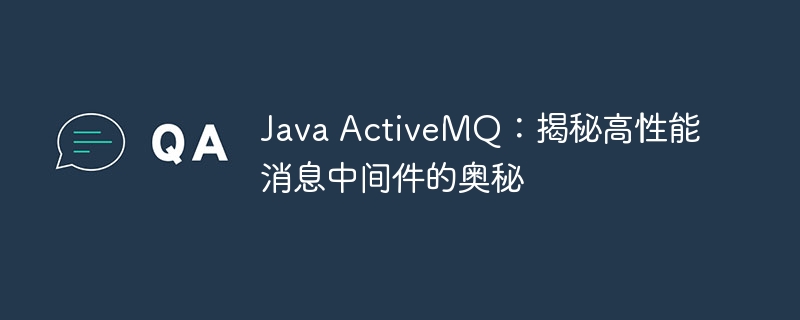Home >Java >javaTutorial >Java ActiveMQ: Uncovering the secrets of high-performance messaging middleware
Java ActiveMQ: Uncovering the secrets of high-performance messaging middleware
- WBOYWBOYWBOYWBOYWBOYWBOYWBOYWBOYWBOYWBOYWBOYWBOYWBforward
- 2024-02-19 14:51:311175browse

Java ActiveMQ, as a high-performance messaging middleware, is widely used in enterprise-level systems. Its stability and reliability are highly regarded, but its inner workings are the focus of many developers. In this article, PHP editor Apple will reveal the secrets of Java ActiveMQ and give you an in-depth understanding of the working principle and performance optimization techniques of this message middleware.
Java ActiveMQ is an open source messagingmiddleware, designed to provide applications with a reliable, scalable, high-performance messaging mechanism . This article will delve into the high-performance mysteries of Java ActiveMQ from the following aspects:
1. Lightweight core and asynchronous communication
The core design idea of Java ActiveMQ is lightweight and asynchronous communication. It adopts an asynchronous messaging model, that is, after the producer sends the message to the message middleware, it does not need to wait for the consumer to receive it immediately, but continues to perform other tasks. This asynchronous communication method greatly reduces system overhead and improves throughput.
Code example:
import org.apache.activemq.ActiveMQConnectionFactory;
import javax.jms.*;
public class Producer {
public static void main(String[] args) throws Exception {
// 创建连接工厂
ActiveMQConnectionFactory connectionFactory = new ActiveMQConnectionFactory("tcp://localhost:61616");
// 创建连接
Connection connection = connectionFactory.createConnection();
connection.start();
// 创建会话
Session session = connection.createSession(false, Session.AUTO_ACKNOWLEDGE);
// 创建队列
Destination destination = session.createQueue("test.queue");
// 创建消息生产者
MessageProducer producer = session.createProducer(destination);
// 创建文本消息
TextMessage message = session.createTextMessage("Hello, ActiveMQ!");
// 发送消息
producer.send(message);
// 关闭资源
producer.close();
session.close();
connection.close();
}
}
In the above example, the producer sends the message to the queue "test.queue" asynchronously, and can continue to perform other tasks without waiting for the consumer to receive it immediately, which improves the system throughput.
2. Efficient memory management
Java ActiveMQ cleverly uses memory management technology to ensure high-performance transmission of messages. It uses non-heap memory to store messages, thereby avoiding frequent cleaning of heap memory by the garbage collector, reducing system overhead and improving message processing efficiency.
Code example:
import org.apache.activemq.ActiveMQConnectionFactory;
import javax.jms.*;
public class Consumer {
public static void main(String[] args) throws Exception {
// 创建连接工厂
ActiveMQConnectionFactory connectionFactory = new ActiveMQConnectionFactory("tcp://localhost:61616");
// 创建连接
Connection connection = connectionFactory.createConnection();
connection.start();
// 创建会话
Session session = connection.createSession(false, Session.AUTO_ACKNOWLEDGE);
// 创建队列
Destination destination = session.createQueue("test.queue");
// 创建消息消费者
MessageConsumer consumer = session.createConsumer(destination);
// 接收消息
Message message = consumer.receive();
if (message instanceof TextMessage) {
TextMessage textMessage = (TextMessage) message;
System.out.println("Received message: " + textMessage.getText());
}
// 关闭资源
consumer.close();
session.close();
connection.close();
}
}
In the above example, the consumer receives messages asynchronously from the queue "test.queue" and prints the message content. Since Java ActiveMQ uses non-heap memory to store messages, consumers do not need to wait for the garbage collector to clean up the heap memory, thus improving message processing efficiency.
3. Reliable message transmission mechanism
Java ActiveMQ provides a series of reliable message transmission mechanisms to ensure that messages are not lost or damaged during transmission. It supports persistent messages, stores messages in reliable storage media, and ensures message integrity even in the event of system failure or power outage.
Code example:
import org.apache.activemq.ActiveMQConnectionFactory;
import javax.jms.*;
public class PersistentProducer {
public static void main(String[] args) throws Exception {
// 创建连接工厂
ActiveMQConnectionFactory connectionFactory = new ActiveMQConnectionFactory("tcp://localhost:61616");
// 设置持久化连接
connectionFactory.setUseAsyncSend(true);
// 创建连接
Connection connection = connectionFactory.createConnection();
connection.start();
// 创建会话
Session session = connection.createSession(false, Session.AUTO_ACKNOWLEDGE);
// 创建队列
Destination destination = session.createQueue("test.queue");
// 创建消息生产者
MessageProducer producer = session.createProducer(destination);
// 设置持久化消息
producer.setDeliveryMode(DeliveryMode.PERSISTENT);
// 创建文本消息
TextMessage message = session.createTextMessage("Hello, ActiveMQ!");
// 发送消息
producer.send(message);
// 关闭资源
producer.close();
session.close();
connection.close();
}
}
In the above example, the producer ensures that the message will not be lost during the sending process by setting the message to persistence mode. Even in the event of a system failure or power outage, the consumer can still receive and process the message from the queue.
4. Scalability and high availability
Java ActiveMQ supports cluster deployment and can be easily expanded to multiple servers to meet growing message throughput requirements. At the same time, it provides failover and load balancing mechanisms to ensure that when one of the servers fails, other servers can take over its work and ensure the high availability of the system.
Code example:
<clusteredBrokers> <broker address="tcp://localhost:61616" name="BrokerA"/> <broker address="tcp://localhost:61617" name="BrokerB"/> </clusteredBrokers>
In the above example, two ActiveMQ cluster servers are configured to achieve load balancing and failover. When one of the servers fails, the other server can take over its work, ensuring continued availability of the system.
5. Rich management tools
Java ActiveMQ provides a wealth of management tools, simplifying system management and monitoring. Administrators can easily view system running status, message throughput, queue size and other information through the ActiveMQ WEB console, JConsole or other third-party tools, and manage and maintain the system.
Code example:
$ jconsole
In the above example, use JConsole to connect to the ActiveMQ server to view system running status, message throughput, queue size and other information.
Summarize
Java ActiveMQ is a high-performance, reliable, and scalable messaging middleware that is widely used in enterprise-level applications, financial trading systems, Internet of Things and other fields. This article deeply explores the high-performance secrets of Java ActiveMQ, including lightweight core and asynchronous communication, efficient memory management, reliable message transmission mechanism, scalability and high availability, and rich management tools. Java ActiveMQ is a trustworthy messaging middleware that builds reliable
for enterprisesThe above is the detailed content of Java ActiveMQ: Uncovering the secrets of high-performance messaging middleware. For more information, please follow other related articles on the PHP Chinese website!

